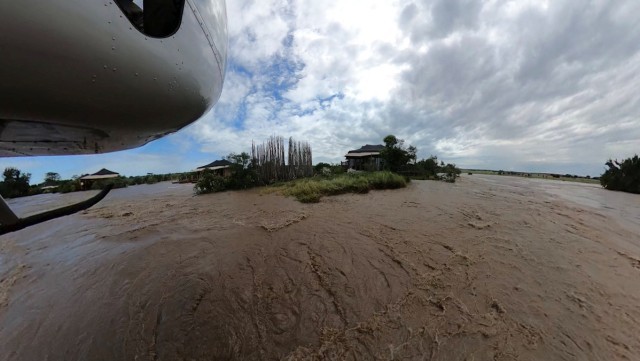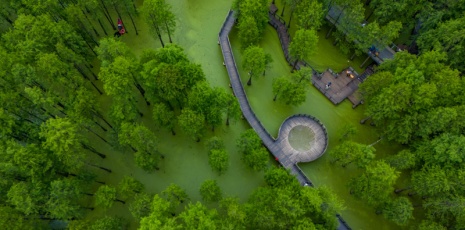
A view from a helicopter shows a safari lodge near the swollen river within the flooded area following heavy rainfall in the Talek region, of the Maasai Mara National Reserve in southwestern Kenya, May 1, 2024. Mara Elephant Project/Handout via REUTERS
Torrential rains and flash floods continued to wreak havoc across Kenya, destroying properties, claiming lives and displacing thousands, as the country remained on high alert for Cyclone Hidaya, which was predicted to hit the Kenyan coast.
On Saturday evening, the Kenya Meteorological Department said the cyclone had weakened after landfall on Mafia Island in Tanzania but warned other depressions were developing and it's closely monitoring them. "Heavy rainfall offshore along the Kenyan coast is likely from Sunday, propagating inland on Monday to Tuesday," the meteorological department said.
"Effects offshore include strong winds exceeding 40 knots and waves surpassing 2 meters. Residents, especially in coastal areas and those in marine activities, are advised to take precautions."
Authorities said on Sunday that the death toll from weeks of devastating rains and floods had risen to 228 and warned there was no sign of a letup in the crisis.
Nearly 205,000 people have been affected across the country and 72 people were reportedly missing as of Friday.
Data from the Kenya Red Cross Society indicated more than 8,000 livestock have been lost due to heavy rains and floods, over 14,000 hectares of croplands and 46 roads damaged, more than 600 small businesses, 39 schools and 13 health facilities affected by Wednesday.
Philes Matha, a resident of Kithimani village in Kitui County, said though the locality has not been affected by floods, whenever the people see heavy clouds, worry overshadows them as they fear their houses could crumble.
"My brother-in-law's house fell on Thursday night due to heavy rains and strong winds. Luckily, he was not hurt," she said.
"We experienced the El Nino phenomenon in 1997 and 1998 but the intensity and destruction was less than the current one."
In a village in Machakos County, Daniel Nduti said he woke up to find that his pit latrine had collapsed due to heavy rains.
Rescue operations
Search and rescue operations were continuing in Nakuru, Nairobi, Kirinyaga, Homa Bay, Machakos and Tana River, which are among the worst-affected areas.
Across the border, the Tanzania Meteorological Authority declared that Cyclone Hidaya had "completely lost its strength" after making landfall on Saturday.
The country's tourism sector has been affected. Several tourists had to be evacuated from Maasai Mara National Reserve after hotels and lodges were flooded.
The Kenya National Highways Authority had to block some of the main roads after they were destroyed by floods, hindering transportation and affecting food supply.
President William Ruto on Friday directed the Ministry of Education to postpone indefinitely the reopening of schools for the second term because of flooding. Schools were scheduled to reopen on April 29 but this has been delayed until Monday.
To fight climate change, Ruto called on Kenyans to intensify their response to an ecosystem restoration plan, which aims to grow 15 billion trees nationwide in the next 10 years.
The United Nations Office for Coordination of Humanitarian Affairs warned that continued flooding and water stagnation may trigger waterborne and livestock diseases.
Already, 34 cholera cases have been reported in Garsen Sub-County in Tana River County by Thursday, according to the health authorities.
Agencies and Xinhua contributed to this story.










